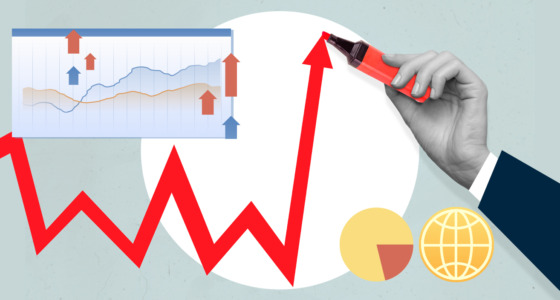

In the following article, we will discuss everything about the Quasimodo pattern. We will review how it works, the best time to trade with it, and more.
What is the Quasimodo pattern?
Quasimodo pattern refers to a reverse pattern of trading that develops at the end of an uptrend. It can also be described as a price formation consisting of two valleys and three peaks, with the center peak being the tallest while the outer peaks equal height. Furthermore, compared to the first valley, the second valley is lower.
Some experts also call it the “Over and Under” chart pattern. The Quasimodo pattern in Forex trading predicts a bullish-to-bearish trend reversal. Two different forms of Quasimodo patterns may be distinguished using the example of market sentiment:
- Bearish Quasimodo appears at the end of an uptrend.
- Bullish Quasimodo appears at the end of a downtrend.
You may have noticed that the Quasimodo pattern resembles the Head and Shoulders trading pattern. Well, you are right. They are similar, but at the same time, they represent different price formations.
Differences between Quasimodo and Head and Shoulder patterns
Head and Shoulder and the Quasimodo patterns differ significantly in two ways. Firstly, the depth of the valleys is not symmetrical when it comes to the Quasimodo pattern since the valleys have distinct pricing structures. Moreover, the two reversal patterns employ two different entrance techniques.
The second valley (left leg) of the Quasimodo pattern is substantially lower than the first valley (right leg), which is the primary distinction between it and the Head and Shoulder pattern. Both valleys in the Head and Shoulder pattern are almost the same size.
In contrast to the HS pattern, the Quasimodo pricing structure is not particularly distinctive. The “malformed” second valley, which shows a Shoulder pattern and crooked head, is where the term Quasimodo originated.
In this sense, the Quasimodo chart pattern won’t be as simple to spot with the naked eye. You must instead employ sophisticated trading indicators. Moreover, the point of entry is the second key distinction that separates the two reversal patterns.
When using the Quasimodo pattern, an entrance order is placed close to the left shoulder rather than the typical point of entry for the HS pattern. Quasimodo is a more complex version of the Head and Shoulder pattern.
One common query traders ask is how we choose which times of day to trade the Quasimodo chart setup. Keep reading for the answer.
The best time to trade with Quasimodo
The best time to trade the Quasimodo pattern is after a significant sell-off or rally. All chart formations are complex and manifest differently throughout various periods, from the 1-minute to the daily chart. For investors that trade using numerous periods, this is excellent news.
The fact that the current trend is present allows us to catch a whole new trend or, at the very least, capitalize from a brief retracement.
Also, compared to trend trading, the Quasimodo pattern gives superior entry points when entry signals are delayed. However, each trading strategy has advantages and disadvantages. Now let’s discuss the workings of the Quasimodo pattern.

How does the Quasimodo pattern work?
The Quasimodo pattern operates on the foundation of an imbalance in the forces of demand and supply. Simply put, it follows changes in the pricing structure.
The continual succession of HH (higher highs) and HL (higher lows) that result in higher peaks and lows is known as market structure. When we have a break in the current HH and HL, the price first starts printing a lower low.
The Quasimodo trading strategy gives us a suitable framework to comprehend the ongoing fluctuations of every asset ranging from stocks and currency to cryptocurrency and commodities, etc.
The market’s transition from a purchasing momentum to a trading momentum is the focus of the bearish Quasimodo pattern. It is revealed after the price cannot create another higher low.
This information may be instructive for some new traders since it gives you a good foundation for examining the pricing system. You must consider that this is merely one way to look at the markets; there are many more.
Quasimodo pattern trading rules
The Quasimodo trading rules for Down signals may be summed up as follows:
- See a current uptrend — a series of High highs followed by a series of High lows.
- Break in the market structure — the price starts to form LL (lower lows).
- Put in a sell order close to the right shoulder.
- Hide a protective stop loss over the last HH.
- Take profit around the first valley of the Quasimodo pattern.
The Quasimodo pattern is much more significant if the second valley is substantially lower than the first. In other words, it grows more crooked the more apart the two valleys are.
Let’s look at a bullish Quasimodo reversal pattern.
The Quasimodo trading rules for Up signals include:
- See a downtrend – a series of LL followed by a series of LH.
- Break in the market structure – the price starts to form HH (higher high).
- Put in a buy order close to the right shoulder.
- Hide a protective stop loss below the last LL.
- Take profit around the first peak of the Quasimodo pattern.
Bonus: Find a simple but highly effective trick for trading trick below.
We can examine the Quasimodo pattern’s crookedness by drawing lines parallel to the price structure. Following this, the Quasimodo price structure will appear on the price chart. We can easily detect Quasimodo’s crookedness when we highlight the price structure.
Quasimodo trading strategy
You don’t need to add complex things to make a pattern provide more precise trade signals. The Fibonacci retracement indicator is the sole additional instrument required to maximize the Quasimodo trading strategy.
Using the indicator, we can predict where the last price movement, a component of the Quasimodo chart pattern, will terminate. The Fibonacci retracement levels may be used to locate trustworthy price support and resistance areas. The price area between the 50% and 61.8% Fibonacci retracements is significant to us, with the 61.8% level as the ideal pivot point.
The quality of the swing lows and highs should be considered while trading the Quasimodo pattern. A mechanical approach must be found to assess the quality of the swing lows and swing highs points.
Generally, we only count points with a V-shaped pattern as qualifying swing highs (swing lows). V bottoms and V tops are other names for this pricing pattern. When the market abruptly shifts from bullish to bearish or vice versa, it is easy to see a V-shaped swing low.
FAQs
Let’s also consider a few points that may interest novice traders.
What is the Quasimodo trading strategy?
The Quasimodo trading strategy is a price-action-based trade method that seeks to locate critical resistance and support levels to spot future market reversals. As the pricing pattern mimics Quasimodo’s hunched-back character in Victor Hugo’s “The Hunchback of Notre Dame,” the strategy was given his name.
What are the workings behind the Quasimodo trading strategy?
The Quasimodo trading strategy looks for price patterns that suggest a possible market reversal. As well as particular price patterns like double bottoms and tops or bearish and bullish divergences, traders who use this method frequently search for important resistance and support levels.
Depending on the projected direction of the reversal, the trader may take a short or long position after spotting a prospective reversal.
What markets will benefit from the Quasimodo trading strategy?
Stocks, foreign exchange, and futures markets are just a few places to use the Quasimodo trading strategy. As these are essential components of the approach, it is especially well-suited for markets demonstrating distinct resistance and support levels.
What are the risks when using the Quasimodo trading strategy?
The Quasimodo trading strategy has some risks like any other trading approach. For example, the technique depends on correctly identifying crucial resistance and support levels, which can be difficult in volatile or changing markets. Quasimodo also has the same risk of losses as any other trading strategy.
What are the benefits of using the Quasimodo trading strategy?
The Quasimodo trading strategy can assist traders in spotting market reversal moments, which can result in profitable trades. It also relies on price movement and significant resistance and support levels, which can be a strong basis for a trading approach.
The bottom line
The Quasimodo pattern is a novel method for identifying trend reversals in trading. The fact that the pattern is new doesn’t mean you shouldn’t attempt it. When every component of this reversal pattern is in place, you can enter the trade at the right time.










